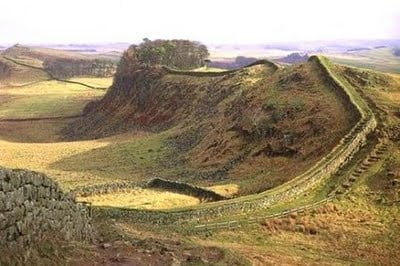 Hadrian’s Wall stretching from the North Sea to the Irish Sea (from the Tyne to the Solway), was 120 km long, 2-3 meters wide and 3-4 meters high. In addition to the wall, the Romans built a system of small forts called milecastles (housing garrisons of up to 60 men) every Roman mile along its entire length, with towers every 1/3 mile.
Hadrian’s Wall stretching from the North Sea to the Irish Sea (from the Tyne to the Solway), was 120 km long, 2-3 meters wide and 3-4 meters high. In addition to the wall, the Romans built a system of small forts called milecastles (housing garrisons of up to 60 men) every Roman mile along its entire length, with towers every 1/3 mile.
 Sixteen larger forts holding from 500 to 1000 troops were built into the wall, with large gates on the north face. To the south of the wall the Romans dug a wide ditch, (vallum), with six foot high earth banks.
Sixteen larger forts holding from 500 to 1000 troops were built into the wall, with large gates on the north face. To the south of the wall the Romans dug a wide ditch, (vallum), with six foot high earth banks.
The main reasons for the construction of the wall was to keep Roman Britain safe from hostile attacks from the Picts.
 Construction of the wall started sometime in AD 122 and was largely completed in 128 AD.
Construction of the wall started sometime in AD 122 and was largely completed in 128 AD.
In the years after Roman Emperor Hadrian’s (reign 117-138 AD) death in AD 138, the new emperor, Antoninus Pius essentially abandoned the wall, leaving it occupied in a support role, and began building a new wall called the Antonine Wall, about 160 kilometres north,
In the late 4th century, barbarian invasions, economic decline, and military coups loosened the Empire’s hold on Britain. By 410, the Roman administration and its legions were gone, and Britain was left to look to its own defences and government.
In time Hadrian’s wall was abandoned and fell into ruin. Over the centuries the stone was reused in other local buildings.
source: www.armenian-history.com
